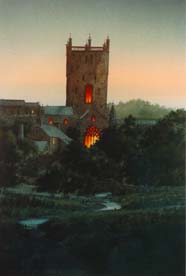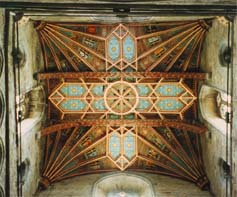St. David's Cathedral
Revered as one of the major places of pilgrimage in the Western world for over 1200 years, St Davids cathedral is situated in a sheltered valley close to the south-west tip of the Pembrokeshire coast in South Wales. To see it for the first time is for many a wonder, standing as it does against a backdrop of open fields and countryside in such a rural setting. The original monastery of Menevia, founded by St. David himself in the 6th century, has long disappeared. It was pillaged several times by Viking raiders in its history.The present cathedral was begun circa 1180 A.D., with additions over the centuries. St. David was born close by, allegedly at the spot where St Non's well now stands. He is known to have lived the life of a very ascetic Celtic monk, and encouraged his followers to do likewise. He was known as 'the waterman', some say because of his sparse food intake, but this could easily refer to his frequent missionary travels by boat, which included journeys to Brittany and Ireland. He was killed by Viking raiders near the end of the 6th century, the exact date is not known. lnterestingly his death was seen by some as retribution for eating meat, as vegetarianism was one of the traditions of the Celtic priesthood, and he was the first bishop to break this rule. The earliest reference to St. David is in an 8th century book written at Tallaght,ln Ireland, which reads that they 'kept the feast day of David of Cille Muni', (the cell or church of Menevia), on March 1st. Pope Calixtus 11, (1119-24), canonised St. David, and declared that Two pilgrimages to Menevia were equal to one pilgrimage to Rome', thus ensuring the Saint's popularity with medieval pilgrims. The shrine of the Saint remains in the cathedral to this day, in the beautiful and peaceful Trinity Chapel, the focal point for the Celtic pilgrim. Today a pilgrimage to St. Davids is a truly exhilarating experience. The area has a very ancient "feel" to it, with 6th century St.Non's chapel (within a prehistoric stone circle), just two miles distant. The small coves and bays nearby were the landing places of the early pilgrims from Ireland, and also those from Brittany and further afield. Visiting the cathedral at a quiet time of the day there is a very strong sense of 'the old', and it is easy to imagine the early and more basic structure of St.David's monastery of Menevia being here prior to the present building. The carved wooden suspended ceiling is the finest of its kind in existence, and the painted wooden ceiling and vaulting beneath the tower is truly magnificent.The picture below is taken looking directly upwards at this wonderful ceiling.


 | ||||
Almost everything about this Celtic cathedral is unique, and it is hardly surprising that some people have described it as "the eighth wonder of the world". The shrine of St.David, behind the great altar, is a fine place to meditate, and add ones appreciation for the beauty and inspiration of this place, along with the thousands of pilgrims who have been here over the centuries. There are some fine ancient Celtic cross slabs set into the altar of the Trinity Chapel, and in a side chapel to the east is another fine 9-1Oth century Celtic slab cross set into the wall. This is called 'The stone of the sons of Bishop Abraham, and close by is another fragment of early Celtic knotwork, reminders of the original monastery of Menevia. To conclude, St.Davids must surely be one of the main focal points of our Celtic Heritage, and certainly, once visited never forgotten.
Click Image to close Window